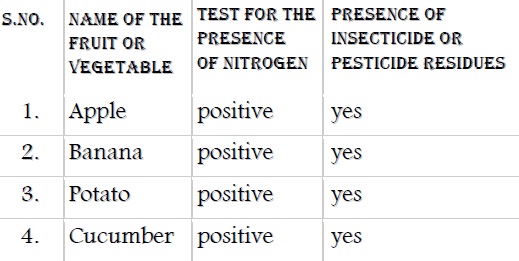





Published on Apr 02, 2024
To Study the Presence of Insecticides and Pesticides in Various Fruits and Vegetables.
In the past decade there has been a tremendous increase in the yields of various crops to meet the demand of overgrowing population, achieved by using pesticides and insecticides.
These are chemicals that are sprayed over crop to protect it from pests. For example: DDT, BHC, zinc phosphide, Mercuric chloride, dinitrophenol, etc. All pesticides are poisonous chemicals and are used in small quantities with care. Pesticides are proven to be effective against variety of insects, weeds and fungi and are respectively called insecticides, herbicides and fungicides. Most of the pesticides are non-biodegradable and remain penetrated as such into plants, fruits and vegetables. From plants they transfer to animals, birds and human beings who eat these polluted fruits and vegetables. Inside the body they get accumulated and cause serious health problems. These days preference is given to biodegradable insecticides like Malathion. The presence of insecticides residues in even raw samples of wheat, fish, meat, butter etc. have aroused the concern of agricultural administrators, scientists and health officials all over the world to put a check over the use of insecticides and to search for non insecticidal means of pest control.
Mortar and pestle, Beakers, Funnel, Glass rod, Filter paper, China dish, Water bath, Tripod stand, Fusion tube, Knife, Test tube
Samples of various fruits and vegetables, Alcohol, Sodium Metal, Ferric Chloride, Ferrous Sulphate Crystals, Distilled Water and Dil. Sulphuric Acid
Nitrogen present in organic compounds is detected by “Lassssaiigne’’ss Tesstt”.. The elements present in the compound are converted from covalent form into the ionic form by fusing the compound with sodium metal. Following reaction take place:

Cyanide of sodium so formed on sodium fusion is extracted from the fused mass by boiling it with distilled water. This extract is known as sodium fusion extract.
1) Take different types of fruits and vegetables and cut them into small pieces separately.
2) Transfer the cut pieces of various fruits and vegetables into it separately and crush them.
3) Take different kinds for each kind of fruits and vegetables and place the crushed fruits and vegetables in these beakers and add 100 ml of alcohol to each of these.
4) Stir well and filter.
5) Collect the filtrate in separate china dishes, evaporate the alcohol by heating the china dishes one by one over a water bath and let the residue dry in the oven.
6) Heat a small piece of sodium in a fusion tube, till it melts.
7) Then add one of the above residues from the china dish to this fusion tube and heat it till red hot.
8) Drop the hot fusion tube in a china dish containing about 10 ml of distilled water.
9) Break the tube and boil the contents of the china dish for about 5 minutes.
10) Cool and filter the solution.
11) Collect the filtrate.
12) To the filtrate add 1 ml of freshly prepared ferrous sulphate solution and warm the contents.
13) Then add 2-3 drops of ferric chloride solution and acidify with dilute HCl.
14) If a blue or green ppt. or coloration is obtained it indicates the presence of nitrogen containing insecticides.
15) Repeat the test of nitrogen for residues obtained from other fruits and vegetables and record the observation.

It is concluded that from the above observations, that each fruit or vegetable contains nitrogenous insecticide or pesticide residues in it.
NCERT Chemistry- XII
Comprehensive Practical Chemistry- XII
www..scribd..com